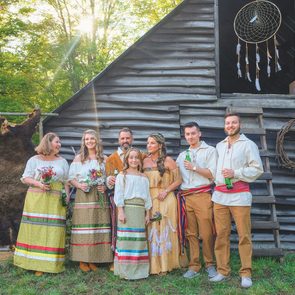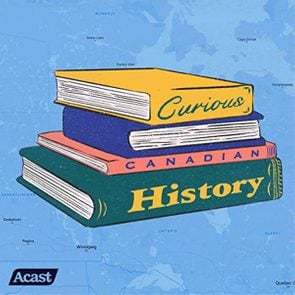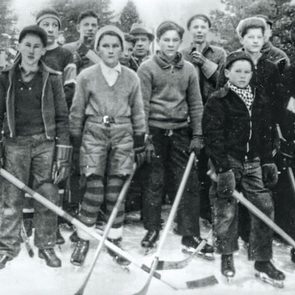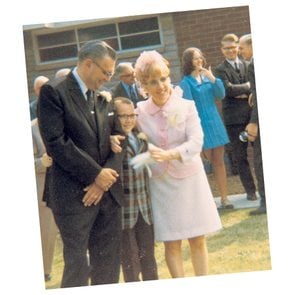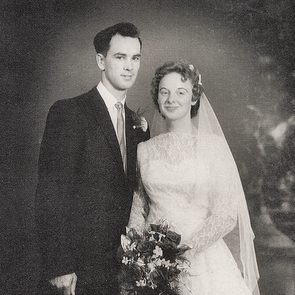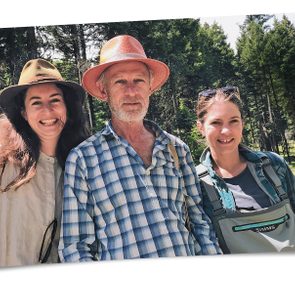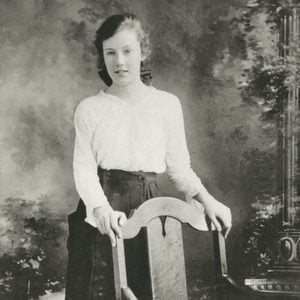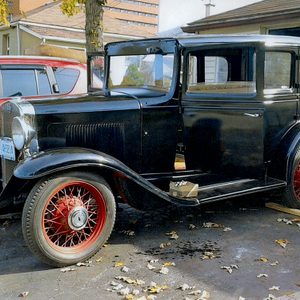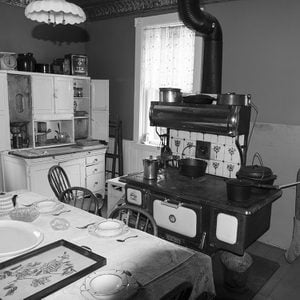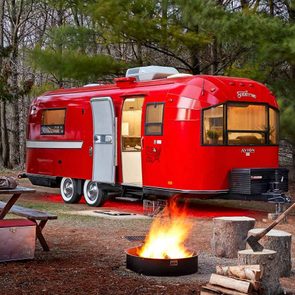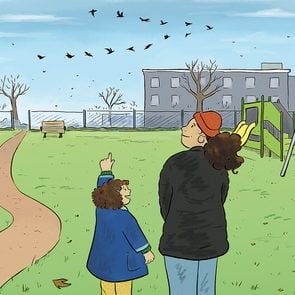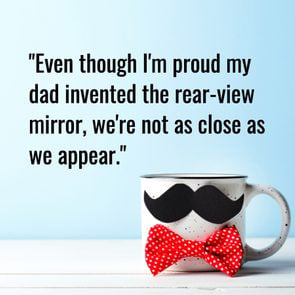When he was nine years old, Theland Kicknosway asked his mother a profoundly difficult question: “What happens to the children of the missing and murdered Indigenous women?”
His mother, Elaine, didn’t have a ready answer, so she reached out to a friend, Bridget Tolley. Hailing from the Kitigan Zibi Anishinabeg community, near Maniwaki, Que., Tolley is the founder of Families of Sisters in Spirit, a grassroots initiative that supports loved ones of missing and murdered Indigenous women, girls, and transgender and two-spirit people. (The number of missing women is reported to number approximately 1,200 across Canada, though activists estimate the true total could in fact be much higher.)
Tolley explained to Theland that it wasn’t easy for the children left behind, many of whom were taken in by grandparents. “It’s tough to know that people you love are gone,” she said.
That idea bothered Theland so much that he became determined to help—to be, in his own words, “a child looking out for another child.” After some thought, he knew what to do. He would run.
Since 2015, his annual marathon, Theland’s Journey, has raised more than $5,000 for Families of Sisters in Spirit. The group, Tolley says, offers money and supplies to the children’s caretakers and also organizes events, such as a free supper in Ottawa in February 2018, where Indigenous women could pick up clothing, toys and household goods.
Theland’s run, she says, has become a key fundraiser for the organization, which has helped about 400 families so far.
The spring’s 134-kilometre trek, which kicked off on March 29, 2018, travels from Kitigan Zibi to Gatineau Park, just north of Ottawa. Community members, local politicians and police officers have been invited to join Theland, now 14, at various points along the run.
The teen’s chosen root has deep significance. Kitigan Zibi is home to the families of Maisy Odjick and Shannon Alexander, best friends who disappeared in September 2008 on their way to a high-school dance. Law enforcement officials have yet to clarify what happened to them.
Gatineau Park is the place where 27-year-old Kelly Morrisseau, a pregnant mother of three, was found in a pool of blood on the morning of December 10, 2006. She was taken to hospital with multiple stab wounds but died that same day. Her murder has never been solved.
Theland trains for his run, which amounts to more than three full marathons in as many days, mostly by playing basketball, his favourite sport. But the challenge remains largely mental, not physical.
“It’s always a tough journey, but we’re doing this for something that has affected many lives,” he says. “I’ve learned that it may seem hard, it may seem tough, but we have to persevere. We have to have that strength to keep moving forward.”
Theland’s father, Vince Kicknosway, is filled with pride for his son. “This is something he came up with out of his own nature,” he says.
Both Vince and Elaine are survivors of the Sixties Scoop, the 1960s to late ’80s practice of taking First Nations children out of their homes and placing them in foster care or up for adoption.
Their son, on the other hand, is a member of the Walpole Island First Nation, in southwestern Ontario, and is an accomplished drummer, singer and hoop dancer. In November 2015, he led Prime Minister Justin Trudeau and the new Liberal cabinet into Rideau Hall for their swearing-in ceremony.
Theland was recently named a 2018 Indspire Award recipient for his contribution to Indigenous culture, heritage and spirituality. He is considering a career as a performer or actor—and he has no plans to stop running.
“I want to do something to help bring change,” he says.
Here’s what you need to know about Mohawk actor Kawennáhere Devery Jacobs.

Ever since he was a young boy growing up in Roblin, Manitoba, Armand Jerome has been intrigued by the history and construction of the traditional Métis Red River cart. His father, Leon, had mentioned how their family had used the Red River cart in the old days, which seemed to quench the young man’s curiosity—that is, until around the year 2000, when Armand joined the newly formed Métis Council Local in his new home of St. Norbert, Winnipeg. There, he met an executive, Don Benoit, and the two became fast friends. At weekly breakfasts, they would discuss world issues, including the plight of the Métis Nation and their struggle to achieve proper recognition and be given the rights due to them. Don often spoke of gathering a crew to build canoes and Red River carts to showcase Métis culture. But due to health problems, he didn’t live to see those goals realized.
In 2001, Armand was chatting with a friend about the North American Indigenous Games that were to be held the following year in Winnipeg. The two thought it would be nice to see a few Red River carts involved in the opening ceremonies. This gave Armand the incentive to follow through on his dream of making carts and driving them. He gathered a crew together from the Métis Local to start researching cart construction.

Building Red River carts was a trade long forgotten; in fact, some of the “blueprints” were merely various personal impressions and recollections of the vehicles. The team lacked historical information about cart building. And although Armand’s crew had the help of someone who’d built carts before, even that man was not sure how they’d hold up in practical use.
As the team built their first four carts, they worked alongside local horse owners to design the most efficient and stable way to hook the wagons up to the animals so as to ensure the carts would be usable.

Once they were built and the crew had experimented with harnessing, the men began to work with their local Trans Canada Trail group on the prospect of driving the carts along portions of the Crow Wing Trail. This path closely follows an original route that Red River cart drivers would travel in the 1800s to transport goods to and from the Red River Settlement, as well as the Crow Wing Settlement on the Mississippi River. The team’s goal was to drive the carts and arrive in Winnipeg in time for the Indigenous Games. Armand recalls that the design of these early-attempt carts was quite inferior to the historical versions, and that they required piecing together every evening just to make another day of use on the trail. Some days, only a couple of carts were used while the others were being repaired. Still, after a gruelling week on the trail, the team made it to the games.
That voyage begat an era of 20-plus years of Red River-cart research and heritage journeys across Manitoba and Saskatchewan, logging more than 3,000 miles on the wagons. Armand’s most outstanding expedition was dubbed “The 800 Miles to Batoche,” during which he travelled the Carlton and Trans Canada trails from St. Norbert to Batoche, Saskatchewan, joined in celebration along the way by various Métis and other groups.
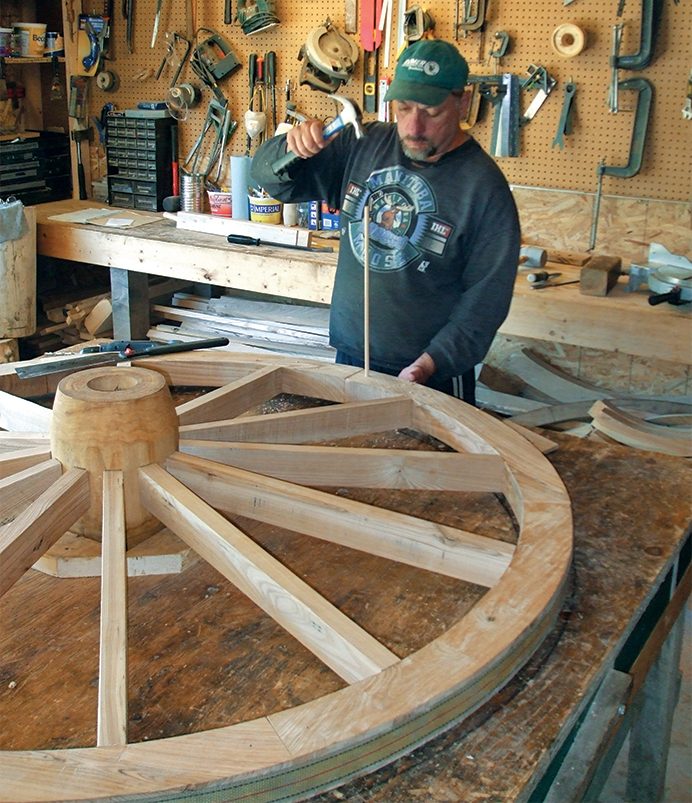
Throughout his treks, Armand remained true to his dream of creating an authentic, historical Red River cart by trial and error, using only the tools and research at hand. In 2008, he was joined by his future wife, Kelly, who’s since worked side by side with him to make this dream a reality. In 2009, they launched Jerome Cartworks, which Armand says produces carts that are as close to the originals as can be made.
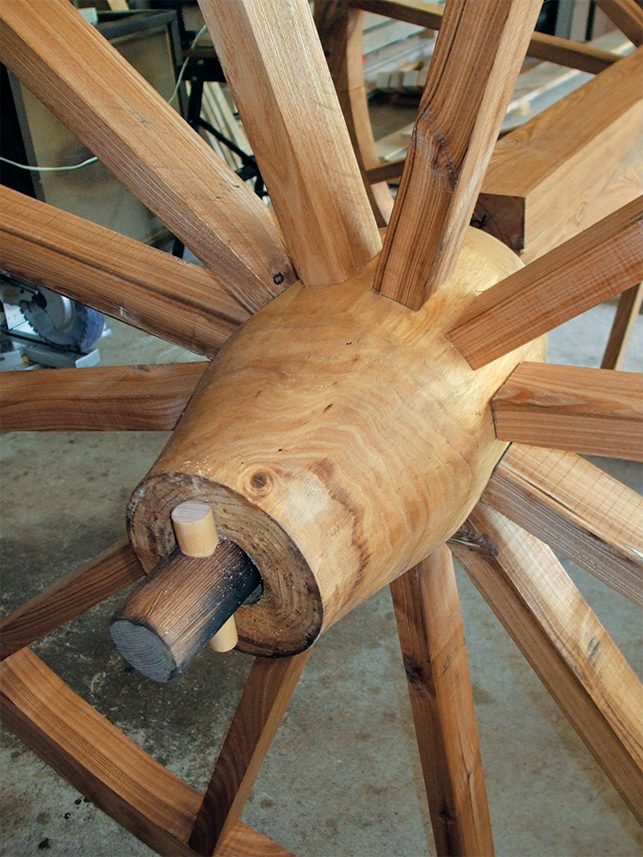
The units are built with local hardwood such as oak—which Armand considers the most functional of the woods—and ash. These were also used in 1800s-era cart construction, as they were indigenous to the Red River Valley and plentiful enough that materials for repairs were available along the trail as needed. The carts’ hubs are made from elm due to this wood’s resistance to cracking. And the basket spindles are made from willow or birchwood, which are harvested in winter only.

It takes a minimum of 200 hours to construct one cart, not counting the time and effort required to gather the various woods and materials. Factoring in wood prep such as bark peeling, planing, dyeing and finishing, the entire build, from beginning to end, is closer to 300 to 400 hours of work.
No metal parts—such as metal bands on the wheels, or even metal screws and nails—are used in the carts. Instead, dowels hold everything together. Due to this all wood composition, the carts are able to float across rivers, though they lack the buoyancy to carry loads across water. To accomplish this, a driver would have to cut a couple of logs, strap the cart wheels on top of the logs, and then strap the cart itself on top of the wheels, essentially converting the wagon into a temporary raft.
Jerome Cartworks, based near Oakbank, Manitoba, has so far created more than 45 carts, which have mostly been used in parades and ceremonies across Canada, including at Métis Locals and RCMP headquarters.
Next, check out 20 unique artifacts you’ll find in Canadian museums.
That’s right. You heard it here first: Thanks to a new partnership between Heinz and Wonder, you can finally buy packages of hot dogs and buns in equal amounts—specifically, 10 of each. That means no more buying two packs of eight hot dog buns to finish off one pack of 10 hot dogs (with the inevitable leftover buns going stale and ending up as birdfeed).
If you’re wondering why the two items were sold in uneven quantities in the first place, the answer is a matter of measurement. Basically, hot dogs are sold by weight and buns by the baking pan. The National Hot Dog and Sausage Council (NHDSC)—yes, it actually exists—explained to us in 2021 that, “Sandwich rolls, or hot dog buns, most often come eight to the pack because the buns are baked in clusters of four in pans designed to hold eight rolls.” On the other hand, 10 hot dogs (weighing roughly 1.6 ounces each) provides an optimal total package weight of an even pound. Mystery = solved.
A Game-Changer For Home Grilling
Aware of this dilemma, Heinz initiated a petition in the summer of 2021 to “change the hot dog industry for the better” and have buns and dogs sold in equal quantities. A couple negotiations and more than 30,000 petition signatures later and we never have to waste a single dog or bun ever again thanks to new 10-packs of Wonder buns.
According to Nina Patel, Head of North American Brand Communications at Kraft Heinz Company, it’s a game-changer for home grilling. “Heinz has brought hot dogs and buns together for more than a century, so we felt like it was our duty as the world’s most iconic ketchup to rally our passionate fans and champion change for the age-old issue of unequal buns and wieners packs,” she says.
Where to Find the New 10-Pack Hot Dog Buns
Beginning June 23, the Wonder 10-pack hot dog buns will be available in Ontario through No Frills, Real Canadian Superstore, Your Independent Grocer, Dollarama, Valu-mart and Fortinos. Heinz is hopeful that the limited edition offering will eventually roll out across Canada, and the company is encouraging hot dog lovers from every province to sign the petition to ensure national availability.
Judging by the response on Twitter, though, we won’t have to wait long for all Canadians to enjoy the total bliss of buying and consuming evenly-packaged hot dogs and fluffy buns. Not to mention the reduction in food waste. Seems like a win-win to us!
Hot Dog Lovers: Heinz Hot Dog Pact – Sign the Petition! Buns and dogs should match quantity!!! https://t.co/FqD5jRHevH via @Change
— Jeremy S Dobson (@JeremySDobson) July 9, 2021
stop the wrong number of hot dogs plus buns pleeze! 🌭
Hot Dog Lovers: Heinz Hot Dog Pact – Sign the Petition! https://t.co/nicQ8tCsNz via @CdnChange— Otis Fuzz (@TheRealOtisFuzz) July 7, 2021
Every hot dog needs a bun.
We’re supporting @HeinzTweets Hot Dog Pact calling on Big Bun and Big Weiner companies to sell buns & weiners in even amounts to reduce the number of bun-less hot dogs wasted at BBQs all over the world. 🤝
https://t.co/YFPHaDfLON#MakeTasteNotWaste pic.twitter.com/hTjOxzmg1T— Hellmann’s (@Hellmanns) July 14, 2021
You’ve been warned Big Bun industry. It’s time to right this wrong.
10 buns
10 weiners
1 great campaignHEINZ HOT DOG PACT Hot dog The company started a petition that calls for hot dog packages and buns to be sold in the same amount. #HeinzHotDogPact @heinz_ca pic.twitter.com/cIS2Gy71m3
— Elaine Behavior Design (@elainepuma) July 9, 2021
Next, check out 10 ways to take your hot dogs to the next level.
Susan MacLeod used to demand attention at work a little too often. At her Halifax home, she had a comfortable dynamic with her husband and their two teenage children. But at the office, she bowled over her fellow colleagues on the hospital communications team. “I would say, ‘Here’s my idea and I think it’s the best idea,’ and I got very annoyed when people didn’t agree with me,” she says.
Over time, MacLeod, now 66, experienced the Aha! and Ugh! moments familiar to those of us who realize we have some stuff to work on. First, a team-building exercise prompted a co-worker to see that he dominated conversations—MacLeod recognized the same ears-on-me tendencies in herself. She began to reflect inward and wasn’t happy with everything she saw.
Many of us, like MacLeod, can be occasionally self-centred. It doesn’t mean you have narcissistic personality disorder, a rare clinical mental health condition defined in part by a deep need for attention and admiration. Nor does it mean you’re a bad person: a healthy shot of narcissism empowers us to speak up and confidently claim our rightful place in the world.
Left unchecked, however, an inflated sense of self-importance, hitched to the lack of empathy that defines narcissism, can trample over the needs of others and hurt our relationships. If you do sometimes believe you are the one and only cat’s meow, take heart. We can get better at not thinking we are better than everyone else.
Explore the Roots of Your Self-Centred Behaviours
Looking back, MacLeod believes she was overcompensating for an insecure childhood. She knew her parents loved her and did their best. But self-esteem wasn’t generally a priority for families in the 1950s, and her artistic bent wasn’t encouraged. Her parents didn’t think she could draw. She eventually connected the dots between her childhood and the behaviours she wanted to change. “I realized that my personality responded with a great deal of insecurity and later ping-ponged between that and extreme self-confidence,” she says.
Rod Wilson is a former clinical psychologist and Vancouver-based author of Thank You, I’m Sorry, Tell Me More. “The core of narcissistic tendencies is usually about some kind of wound in your personal history where you felt completely inadequate or abandoned and not valued,” he says. As an adult, that person may start to compensate, masking their true self-image.
That buffering can happen in all sorts of ways. As an example, Wilson points to a shopper who enters a store and demands preferential treatment because they see their needs as taking priority over those of others. Parents with narcissistic tendencies might revel in the accomplishments of their children because those achievements reflect well on them. Or conversely, the parent may envy the children because their success takes attention away from them. Or a spouse might make excessive requests of their partner without appreciating the impact.
Luckily, once a person can name their narcissist tendencies, they are well on their way to dealing with them in a healthy way. “Start practising things that will change you,” says Wilson. “We can all do this.”
Find Someone You Trust
How we communicate with others, even in day-to-day chit-chat, can be where the rubber meets the road in narcissistic tendencies. Julie Blais Comeau is a Gatineau executive coach and etiquette officer who has trained politicians, business leaders and other professionals on how to communicate with empathy. Blais Comeau suggests seeking out a trusted role model who seems to be a well-liked, gracious person and a gifted conversationalist. Then ask that person: what could I do to make it better when we engage in conversation?
This will be challenging, says Blais Comeau. “You’re making yourself very vulnerable. But opening yourself up and asking for pointers can help.” The same technique of finding a role model in selflessness can work with marriage and parenting relationships. Who do you know who puts others first in a healthy and balanced way? (They sound exactly like someone who would give you a hand.) If you are the Gabby Garth or the Chatty Cathy of a group, Blais Comeau says practising phrases like, “Tell me more,” can help us all talk less and listen instead.
Do the Opposite of What You Did Before
When MacLeod was trying to stop herself from taking centre stage so much, she would bite her lip to remind herself to let others shine. As she practised listening to, and enjoying, the conversation around her, she reminded herself: it seems to be fine without me. She began to speak up again only after it became easier for her to give others room to contribute.
Self-centred behaviours, like overtalking, can be flipped on their heads with effort. It’s not easy, but once we identify a narcissistic thread in our behaviour, trying to do the opposite can help. Instead of entering a room and immediately launching into a story of your day, try asking your friend or partner a specific question about theirs. Continue with questions and interest.
A sense of entitlement can be offset by empathy. Ask, What are others experiencing? rather than, How can others give me what I deserve? adds Wilson. If you’re the shopper who asks that your needs be met first, remind yourself that you’re not actually the centre of the universe, he says. If you’re the parent basking in the light of your child’s accomplishment, tell yourself they are their own person, and so are you. If you’re the spouse making selfish demands, debrief with your partner regularly and ask them how you can meet their needs, as well.
MacLeod found that meditation classes and therapy helped her find a healthier balance between her regard for self and others. She also began sketching her mother and friends in the nursing home where her mother lived. The resulting graphic memoir, Dying for Attention, details helping her mom navigate long-term care, an experience that called on the empathic powers she’d practised over the years. “It also helps to have a sense of humour. We need to learn not to take ourselves so seriously,” says MacLeod, who is grateful she acted on her desire to change. “I saw that I had an opportunity to grow and I took it.”
Now that you know how to share the spotlight, check out expert advice on how to improve communication in your relationships.
Many Tibetans have never set foot in their homeland, and for much of her life, author Tsering Yangzom Lama was one of them. In the early 1960s, after the fall of Tibet to Chinese forces, Lama’s parents and grandparents fled their country of origin, leaving their grassland villages, crossing the Himalayas and settling in Nepal. Lama grew up in Kathmandu, where she could see Mount Everest from her school bus, and later lived in New York, Toronto and Vancouver. When Lama was 26, she hiked for seven days to the border separating Tibet and Nepal, marked by an army camp, where she saw her homeland for the first time. “What stretched before us was the land and the sky. On and on, across my mother’s village, across my father’s ancestral pastures. Across the prison camp where my great-uncle died, where many heroes remain bound,” she wrote in an essay about the experience.
We Measure the Earth with Our Bodies, Lama’s debut novel, is inspired by her family’s long-ago flight, documenting the experiences of statelessness that followed them across borders. The story revolves around two sisters, Lhamo and Tenkyi, who are preteens when the Dalai Lama flees Tibet for India after a failed Tibetan uprising against Chinese occupation in 1959. The following year, the girls’ mother—who serves as the village oracle—decides they must leave their homeland. They travel on foot to a series of makeshift camps, sleeping in yak hair tents and foraging for food and water, eventually losing their parents to illness and despair. Then comes a longer exile in Nepal. Finally, Tenkyi lands in Toronto, where she’s later joined by Lhamo’s daughter, Dolma, in the west-end neighbourhood of Parkdale, where refugees have clustered in a so-called Little Tibet. The novel jumps between time periods and locations. Each new spot, they find, is a diluted version of the original. “A copy of a copy of home,” Dolma says of Toronto and Little Tibet.
The novel follows the sisters and their loved ones as they live together and apart, always in exile. Lama’s writing is gorgeous, sketching a world both impressionistic and richly detailed, especially when filtered through the perspective of teen girls: to Lhamo’s eyes, for example, her mountain camp is “a buffalo sunning on a hill, revealing everything,” while a Kathmandu refugee camp is a dense forest of alleys and twisting paths. Her depiction of Toronto, meanwhile, crisply challenges Canada’s “It’s a Small World” self-image. “It soon dawned on me that paperwork alone wouldn’t be enough to make us belong,” Dolma says. “We wore our difference on our bodies, not just in our dark hair and brown skin but in our posture, the slower, foreign rhythm of our steps.” Instead of jolly diversity, she encounters casual colonialism. One of the novel’s central mysteries involves the disappearance and reappearance of a ku, or Nameless Saint, a small, ancient statue made of mudstone from Tibet. One evening, decades after the ku has vanished from the family’s camp, Dolma attends a cocktail party at the home of a wealthy art collector in Toronto’s plush Rosedale neighbourhood. There, she discovers none other than the priceless ku, purchased from an anonymous antiques dealer in Nepal. To the collector, the statue is a trophy. To Dolma, it’s her family’s last physical link to their homeland, and she goes to drastic lengths to get it back.
The novel spans decades and continents, its characters infused with both wistful homesickness and fury at their own displacement. The farther they get from Tibet, the farther they grow from each other, and Lama makes you viscerally feel this longing for belonging, the same thing she felt standing at the border between Tibet and Nepal at age 26. The result is something rare in a book of this scale: a novel that’s as moving as it is ambitious.
Next, find out what makes musician Martha Wainwright’s fiery memoir a must-read.

So, apparently it’s time for “the playoffs” to start up again. If this information fills your soul with purpose and joy, great! But if it makes you feel a creeping sense of dread as you brace yourself once again to be brutally excluded from every known social interaction, please voyage back in time several years with me to one particular office I worked at. Because I think I can help.
Every day around this time of year, there’d be a pause in our team meeting. The air in the room would shift. And I’d instantly know, on a cellular level, that the moment had arrived. I’d glance anxiously at the clock. Our lunch break was 6,000 hours away. Or just one hour. Same thing. My senses grew heightened. I was the arctic hare of this office, listening, twitching, awaiting the inevitable.
They’d all lean back in their chairs. Laptop screens pushed down, various body stretches executed. That was enough work, apparently. And then, sure enough:
“Okay what the hell was that game last night?”
It’s impossible to overstate how passionate, and how constant, the hockey discussion was in this job. Unfortunately, I had nothing to contribute to any hockey conversation at any time, other than repeatedly shrieking “they play it during the Olympics!!”
One day I was venting my frustrations to a co-worker, Mike—a person who knows a ton about hockey while also possessing an acute awareness of how alienating the sports universe is to an outsider. I’d expected him to sympathize and ask which esophagus-destroying coffee kiosk in the basement food court we should give our hard-earned money to today.
Instead, he leapt into action like he’d been waiting his entire life to rescue someone trapped in an endless Groundhog Day-esque hockey conversation she was constitutionally unable to participate in.
“You need stock phrases,” he replied with alarming immediacy. “Completely empty, meaningless sentences you can throw into any hockey conversation to sound like you’re an authority.”
He emailed me a list that day. And I deployed them constantly, with a barely contained and delirious joy. I’d shout one with my feet up on the table, loudly smacking my gum. Then I’d cut people off mid-sentence to shout another. I simply would not be stopped. I would be stared at and laughed at by my whole office, but I was too enamoured of my new identity—a fun, opinionated person I named “Hockey Janet!”—to care.
In case you, gentle reader, ever find yourself in a similar predicament, I share these sacred phrases with you now. Wield them with gleeful abandon and enjoy the sweet new feeling of—what’s this?—belonging.
7 Stock Hockey Phrases That’ll Come in Handy
- “They’re just not moving the puck.” You don’t need to know which two teams played; one of those teams failed to move the puck adequately.
- “He’s really changed the culture.” At the first mention of a last-namey-sounding word—Tavares! Matthews!—fire this into the discourse. Was the name mentioned disparagingly? With awestruck reverence? There’s no time for irrelevant details; buddy’s changed the culture either way.
- “There’s always next season.” Who can argue with this?
- “I’m worried about their depth.” Apparently the defensive line (that’s right: I did actually pick up some real terms, too) has to be a certain number of players deep to work optimally. Expressing fear about this not happening? Startling power move. Congratulations, you’re now the undisputed Lord of the Conversation.
- “That guy has a real feel for the game.” It means literally anything. It also somehow means literally nothing.
- “Say what you want, but the schedule hasn’t done them any favours.” If in doubt, you can always feel confident asserting that the players’ punishing schedule is the reason for their failure to perform good hockey.
- “They’ve gotta start letting the game come to them.” What? I have no idea, but this instantly makes you sound like a revered hockey commentator with nine municipal parks named after you and that’s all that matters here.
Next, build on the foundation of these hockey phrases with our ultimate guide to Canadian hockey slang.

There was no one like him
My dad was my hero. At six foot three and 285 pounds, he was a giant of a man. He was also immensely strong: he could lift a 45-gallon, 500-pound barrel of diesel fuel onto a truck. On one occasion, he lifted a reticent 600-pound steer onto a stone boat. When I was in grade school, none of my buddies ever said, “My dad is tougher than your dad.”
When God made my dad, he threw away the mould. There was no one like him. And my dad was smart—brilliant, actually. Despite the fact that he had only a rudimentary elementary school education, he was a first-class blacksmith, pressure welder and journeyman. He was highly educated in his line of work. If it was made of iron, he could fix it or make a new one.
Typically, Dad began his day at 4 a.m. with breakfast. While my mother and we kids were sleeping, Dad was loading up on extremely high-calorie, cholesterol-laden food—slabs of bacon with six eggs swimming in the fat, and bread with thick butter, all washed down with steaming mugs of black coffee. Then, by 5 a.m., it was off to the shop.
Blacksmith work came first. Rows of farmers’ cultivator sweeps awaited. First, Dad would build a coal fire in the forge. When the embers were glowing-hot, he’d place four cultivator sweeps on the coals. Then, when they were red-hot, he’d move them aside and put four more in the fire. He’d flatten out the edges of the first four, one at a time, with hammer on anvil. Then he’d temper them in a water trough.
Ploughshares were a different story. Typically, six inches of the worn-down front point had to be removed with a cutting torch and a new factory-made point welded on. The ploughshare was then heated in the forge and shaped with a trip hammer (a mechanical device operated with a foot pedal) and blacksmith hammer, then tempered in a water trough. Heavy coulter ploughshares were the most difficult to repair: A strip of grader blade had to be welded onto the instrument’s cutting edge, heated in the forge, then pounded, flattened and shaped with the trip hammer and, finally, tempered. It was extremely hot work. Dad drank a gallon of water at a time. In summer, you could see streaks of salt on his coveralls.

All work and some play
Around 9 a.m., Dad’s blacksmith work was done for the day, so it was time to turn his attention to constructing stock tanks and repairing various items of machinery. He also worked on cars: One vehicle after another was put up on the hoist, then he installed shocks and mufflers, welded frames and gas tanks, soldered radiators and did oil changes.
How competent a welder was Dad? He had no peer—no equal. A good example was how he’d remove a broken manifold stud. First, he would place a small piece of pipe over the stud and weld from inside the pipe until he reached the top. Next, he would weld a nut to the top, heat up the surrounding metal with a cutting torch and turn the broken stud out. No one else could do that.
Another of Dad’s specialties was repairing vehicle gas tanks. There wasn’t a lot of pavement north of Meadow Lake, Saskatchewan, where we lived, so gas tanks got pretty beat up. Dad would remove the tank and, so it wouldn’t blow up, run an exhaust hose from a gas-driven welder or half-ton truck into it for a half-hour. Then he would shape a piece of 20-gauge sheet metal over the hole, hammer it to fit the contour of the tank and weld the perimeter with an oxyacetylene torch. On one occasion, when the truck ran out of gas, the tank blew just enough to smooth out all of its wrinkles and dents. It looked like a new gas tank. The customer was amazed.
Dad was a kind and generous man. He would lend money to down-and-out people, with no hope of ever being paid back. His other great love was gardening. His half-acre garden behind the shop yielded more than the family could hope to use. So folks, including people Dad didn’t even know, were free to help themselves to his produce—as much as they wanted.
Dad was not a religious man, except for a short while on Sunday mornings. He would be stirring dark, ground whole wheat pancake mix with his huge baseball mitt-sized hands while singing religious songs in his deep bass voice, accompanying Pat Boone and others singing “How Great Thou Art.” When the morning’s LP was over, religion was over for the week, until the next Sunday.
Incidentally about his pancakes: Everybody, including the grandchildren, was expected to have one and then say something along the lines of, “Grandpa, are these pancakes ever good!”—even though they weren’t.
Dad usually finished off his week by stopping by the Empire for a drink before coming home. Invariably, he was accosted by someone who wanted to “twist wrists with Wilf ”—the test of a strongman, and Dad was the person to beat. The bet was always for $20—and Dad always came home with an extra twenty in his pocket.
Next, read the heartwarming story of how one man reconnected with his father through email.
The Great Depression left scars on everyone who lived through it, but time has proven that it was actually not all bad. With approximately one out of every four men unemployed, introspection was forced on the population.
Among the “good” things the Depression fostered was salvaging and reusing items that today would be discarded as garbage. As the old proverb says, “Use it up, wear it out, make it do, or do without.” Very little was wasted. Old shoes, for example, were stripped of their laces to be used as replacements for broken ones, or even for tying up bundles of papers. The tongues of those old shoes served as patches applied to the insides of blown bicycle tires.
Newspapers deserve special attention due to their versatility. For example, they could be wrapped around green fruit to hasten ripening; moulded into small pots for planting; used as rags for cleaning windows; made into covers for text books; lined a pet’s litter box; provided padding for packing fragile items and even used to make papier mache. In addition, they were recycled to wrap up garbage scraps, or to wrap up and order from Joe’s Fish and Chips—the newspaper kept the food hot while the delivery boy rode his bike to deliver it to a hungry customer. And finally, they made great fire starters for the stove, furnace or fireplace.
Hand-me-downs were the order of the day with new clothing being a rarity. In some families, the sweater you saw on one sibling last year reappeared on another one this year—patched for sure, but still serviceable. One more use for old newspapers was that they could be wrapped around the body of the same sweater-wearer for added warmth.
Children made their own activities back then and knew better than to ask for what could not be provided, such as sports equipment. In a road hockey game, for example, padding consisted of newspapers layered under coats and magazines stuffed into stockings to act as shin pads. There were other “street” games as well, each with its own set of rules, administered by us children without adult input or interference. There seemed to be an invisible “game clock” that dictated what time of year each game should be played. Fence walking and “relievo” for example were enjoyed in the fall, preferably at dusk. Relievo (where players on one team hide and are then sought out by members of the other team, who try to capture them and keep them in “jail” while the captives’ teammates try to free them) was particularly rough. Often, when a player was captured he’d resist to the point where his jacket was torn—a fact that was always hidden from our mothers, as such shenanigans ended in physical punishment—after all, jackets don’t grow on trees, you know!
Life was simpler back then and kids handled the rules, punishments and parameters as they came. It was also a way of life that had its own rewards, including the freedom to roam. We were able to build self-reliance, thanks to growing up in a world where you made do—or had to do without.
Next, check out 30 Depression-era cooking tips worth trying today.
The past couple of years have been challenging for everyone. Getting out in nature and enjoying safe outdoor activities help maintain a sense of normalcy, so camping has become extremely popular. In these parts, campground reservations are snapped up faster than tickets to a Justin Bieber concert or a Vancouver Canucks home game.
On this day, my husband, Chuck, and I are excited to leave for Green Point Campground in Pacific Rim National Park Reserve. It’s one of our favourite campgrounds, located in the spectacular Long Beach area of Vancouver Island’s west coast.

It takes us approximately six hours to drive to the west coast from our home in Victoria. There is no ferry travel on this trip, which is always a bonus. We stop often to soak in and capture the spectacular scenery along the way.
We always stop in Coombs, B.C., a small community along Highway 4A. Many tourists visit the Old Country Market there to get a look at their famous “goats on the roof” who bunk during the spring in enclosures on the large, gently sloping market roof and graze on the roof’s grass, keeping it green and tidy. Chuck and I usually refuel with a cone from their amazing ice cream parlour. (Check out more iconic roadside attractions across Canada.)
Our drive takes us through MacMillan Provincial Park, world renowned for its lush, old growth forest and the majestic giant Douglas fir trees in Cathedral Grove.

We wind through mountain passes and drive alongside beautiful crystal-clear lakes. Favourite rest stops include Sproat Lake and Kennedy Lake provincial parks.
Chuck and I have travelled this scenic route many times, yet it never grows old. We still discover new picturesque and stunning views on every trip.
We arrive at our campsite and let out a collective sigh of contentment. Long Beach is now our home away from home.

We have slept in tents on many past camping adventures, but now we usually stay in our eight-foot camper. This reliable and cozy shelter holds many wonderful memories of years gone by, camping with our two energetic young daughters and an often wet dog. Now, although the two of us have more room to stretch out, we miss the giggling and shenanigans of our previous fun family adventures.
Chuck is one of the original Boy Scouts. He gets a campfire started in all weather conditions despite a lack of dry wood. He knows how to tie complicated knots, pound pegs into dry, rocky ground and dig trenches to redirect puddles away from our campsite.
He’s also the Clark Griswold (of National Lampoon’s Vacation movies) of camping. He always brings along at least a dozen tarps of various sizes. We share our viewpoints to choose the one we’ll use: I want to see the trees in the forest surrounding our campsite and he wants to protect and shield us from the elements. After 45 years of camping together, we have learned to compromise. The result is a dry, warm shelter and a tranquil, beautiful view.
The saying “There’s no such thing as bad weather, only bad clothing” is especially true on the west coast of Vancouver Island. We are prepared for all types of weather. In the summer months, the temperatures can range from 7°C to 20° C. And in the cooler seasons, especially, expect rain!

Everything tastes better outdoors. We recently tried a new recipe called an Australian campfire damper, a type of bread. The ingredients include flour, butter, milk and sugar. The dough is then wrapped around a stick and cooked over a camp fire. After a few failed attempts and belly laughs, we end up with a tasty, hot treat.

We also bring ingredients for blueberry tea. This classic hot drink includes amaretto liqueur, orange liqueur and tea. It is perfect for helping us stay warm on chilly west coast evenings.

Most importantly, we bring a fun and flexible attitude with us. This is essential, as camping events and the forces of nature are often unpredictable.

There are many reasons why I love to camp. I spend uninterrupted time with my husband, having conversations that traverse the truly important layers of our shared life. Our discussions often contain periods of silence. As author Richard Wagamese wrote, “When you can sit in perfect silence with someone, you truly know how to communicate.”

I go for long, meandering hikes along peaceful forest trails, slowing down to appreciate the extraordinary—and the exquisite beauty in the ordinary. I listen to the rhythm of the ocean, the sounds of nature and the sounds of silence. I lose myself in photography, capturing images I missed at first glance. The picture in front of me changes depending on the angle, the light and the time of day. It helps me gain perspective. I am in awe of spectacular sunsets! Tears stream down my face and I’m grateful that I have been given another day, another breath, another heartbeat on our beautiful planet.

Although I greatly appreciate my day-to-day life and the comforts of home, I also welcome a change of scenery. Camping allows me to vary my routine and step out of my comfort zone. I gain clarity with a renewed sense of peace and purpose, better able to manage life’s challenges. I feel the harmony, balance and beauty in the magnificence of nature.
I am reminded that I’m part of a bigger picture—and I’m incredibly grateful for the breathtaking view.
Next, discover more unforgettable things to do on Vancouver Island.
Ah, bad dad jokes… The pun-filled quips that make every child’s eyes roll, every father’s heart fill with pride and accomplishment, and—now that parents have made their way onto Twitter—the subject of many a tweet. No matter how bad they are, these jokes always manage to get at least a chuckle out of us. Maybe deep down we actually think they’re funny, or perhaps we just love to see our dads smile because they made us laugh. Whatever the reason, here are some of the best dad jokes the Internet can offer. (Don’t forget to check out our funniest knock knock jokes!)
Feeling crabby?
Why don't crabs give to charity?
Because they're shellfish. #dadjokes
— Daddy Poppins (@DaddyPoppinsBlg) April 20, 2017
This story is soda-pressing
I got hit in the head with a can of Diet Coke today.
Don't worry, I'm not hurt.
It was a soft drink.#dadjokes— Syd Collado (@SydCollado) April 20, 2017
Here comes the bride
Why do melons have weddings?
Because they cantaloupe.#dadjokes
— C&C Geekcast (@CandCGeekcast) April 20, 2017
I rest my case, your honour
Do I enjoy making courthouse puns?
Guilty.#dadjokes #jokeoftheday
— Bad Dad Jokes (@baddadjokes) March 8, 2017
Get it? Pro-tractor?
I want to go on record that I support farming. As a matter of fact, you could call me:#punfun #dadjokes pic.twitter.com/1UkgR6fuIi
— First Jimothy (@First_Jimothy) May 9, 2017
Confidence is everything
At O&B with Dad. Hostess: 'Do you have reservations?' Dad: 'No. I'm confident I want to eat here.' #dadjokes #ftw
— Sam (@EssaiSam) August 27, 2015
These pets are always on time
Why did the man name his dogs Rolex and Timex? Because they were watch dogs #weekdayjokes #dadjokes
— David F (@DavidFrischling) April 27, 2017
Dress to impress
What's the difference between a poorly dressed man on a tricycle and a well dressed man on a bicycle? Attire. #funny #dadjokes #sahd
— dadstayedhome (@Dadstayedhome) April 27, 2017
Joke of the month(s)
Can February March?
No, but April May.#DadJokes
— BeardedMOGuy (@BeardedMOGuy) April 18, 2017
The road to recovery
I was addicted to the hokey pokey…
But, I turned myself around. 💃🏻
— Heather (@RedShiningStar) April 22, 2017
Social media is for the birds
Dad: You know, birds might use Facebook.
Us: ?
Dad: Bc we know they already tweet so… #DadJokes— Lawkward Lady (@LawkwardLady) April 26, 2017
Fishing for advice
What's the best way to watch a fly fishing tournament?
Live stream.#dadjokes #luredyouin
— Drew Davis (@Drew_Davis86) April 25, 2017
It’s how we all roll
Not sure if you have noticed, but I love bad puns. That's just how eye roll. #punfun #badumtiss #dadjokes
— First Jimothy (@First_Jimothy) April 25, 2017
What about Beethoven?
Did you hear that Arnold Schwarzenegger will be doing a movie about classical music? He'll be Bach. #dadjokes
— Adam Hill (@chilladam) April 23, 2017
Poor Bob
What do you call a man with no arms or legs in the middle of the ocean?
Bob.#dadjokes
— Dad Jokes (@GoodOldDadJokes) April 20, 2017
Put that rumour to bed
Dad: Did you hear about the kidnapping at school?
Son: No. What happened?
Dad: The teacher woke him up.#dadjokes— Ralph Nelson Willett (@NorthernOvation) April 20, 2017
Not so sharp
My kid wants to invent a pencil with an eraser on each end, but I just don't see the point.#DadJokes
— Brian Mork (Hermit) (He/Him) (@hermit_hacker) April 29, 2017
Math is hard
The difference between a numerator and a denominator is a short line.
…..Only a fraction of people will understand this.#dadjokes #math
— Vince Favreaux (@storyofericnjoe) April 28, 2017
Maybe her phone floats
My wife asked me to sync her phone, so I threw it into the ocean. I don't know why she's mad at me. #dadjokes
— Adam Hill (@chilladam) April 26, 2017
Deep thoughts
My friend keeps saying "Cheer up man it could be worse, u could be stuck underground in a hole full of water"
I know he means well#dadjokes— Vince Favreaux (@storyofericnjoe) April 25, 2017
And of course, the classic bad dad joke
Son: "Dad, I'm hungry"
Dad: "Hi hungry, I'm Dad"#DadJokes
— Dad Jokes (@fatherlyhumor) December 7, 2016
If you enjoyed these bad dad jokes from Twitter, check out our favourite Father’s Day jokes of all time.
